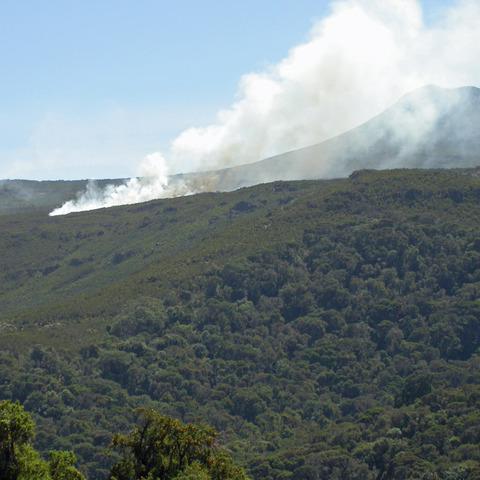当前位置:
X-MOL 学术
›
Journal of Vegetation Science
›
论文详情
Our official English website, www.x-mol.net, welcomes your feedback! (Note: you will need to create a separate account there.)
Fire and grazing controlling a tropical tree line: Effects of long‐term grazing exclusion in Bale Mountains, Ethiopia
Journal of Vegetation Science ( IF 2.8 ) Pub Date : 2020-07-09 , DOI: 10.1111/jvs.12905 Maria Ulrika Johansson 1, 2 , Anders Granström 2
Journal of Vegetation Science ( IF 2.8 ) Pub Date : 2020-07-09 , DOI: 10.1111/jvs.12905 Maria Ulrika Johansson 1, 2 , Anders Granström 2
Affiliation

|
Aims Tropical tree lines are often associated with abrupt shifts in vegetation, soils and disturbance regimes, but the underlying mechanisms are poorly understood. We analysed the role of grazing, fuels and fire in maintaining a sharp tree line with flammable heathland above non-flammable forest. Location Bale Mountains, Ethiopia. Methods The study used grazing exclosures, repeated vegetation sampling, soil analyses and burning and sowing experiments along an altitudinal gradient withHagenia abyssinicaforest,Erica trimeraforest andEricaheathland; all were heavily grazed, the Erica heathland also burnt on short rotation. Results Contrary to expectation, livestock exclusion did not increase flammability in the forest, but instead resulted in a dense carpet of non-flammable herbs. In the heathland, livestock exclusion led to somewhat faster post-fire fuel recovery, but no major change in vegetation. Seeding of tree species resulted in some seedling establishment, but notablyHageniagrew poorly in the heathland, even when protected from livestock. A bioassay, as well as observations of outpost trees on atypical soil above the tree line, suggests that this poor growth is caused by the acidic soils, rather than harsh climate. Despite frequent fires, heathland soils had lower pH and higher organic matter content than forest soils. Below the tree line, tree seedling establishment was successful only in forest gaps, and if livestock was excluded. In both forest and heathland rapid vegetative regeneration in the ground flora after disturbance restricted major species shifts. Conclusions These results suggest that the contrasting fire potential between heathland and forest, and thus the sharp tree line would be maintained, or possibly even accentuated, in the absence of livestock grazing, and thatHageniacolonization upwards into the heathland is restricted not only by fire and grazing, but also the acidic soils, which is a legacy of centuries of dominance byErica.
中文翻译:

控制热带林木线的火和放牧:埃塞俄比亚贝尔山脉长期禁牧的影响
目标 热带树木线通常与植被、土壤和干扰状况的突然变化有关,但其潜在机制却知之甚少。我们分析了放牧、燃料和火在保持锋利的林线和非易燃森林上方的易燃荒地方面的作用。位置贝尔山脉,埃塞俄比亚。方法 本研究采用放牧围场、重复植被取样、土壤分析以及沿海拔梯度的燃烧和播种试验,包括哈格尼亚 abyssinica 森林、Erica trimaforest 和 Ericaheathland;所有人都被严重放牧,埃里卡荒地也在短暂的轮换中被烧毁。结果与预期相反,家畜排斥并没有增加森林中的可燃性,而是导致了一层密密麻麻的不可燃草药。在荒地,排除牲畜导致火灾后燃料回收速度有所加快,但植被没有发生重大变化。树种的播种导致了一些幼苗的建立,但值得注意的是,即使在受到牲畜保护的情况下,Hagenia 在荒地中的生长也很差。一项生物测定以及对林木线以上非典型土壤上的前哨树木的观察表明,这种生长不良是由酸性土壤引起的,而不是恶劣的气候。尽管经常发生火灾,但与森林土壤相比,荒地土壤的 pH 值较低,有机质含量较高。在林木线以下,树木幼苗的建立仅在林隙中成功,并且如果不包括牲畜。在森林和荒地中,受干扰后地面植物群的快速营养再生限制了主要物种的转移。
更新日期:2020-07-09
中文翻译:

控制热带林木线的火和放牧:埃塞俄比亚贝尔山脉长期禁牧的影响
目标 热带树木线通常与植被、土壤和干扰状况的突然变化有关,但其潜在机制却知之甚少。我们分析了放牧、燃料和火在保持锋利的林线和非易燃森林上方的易燃荒地方面的作用。位置贝尔山脉,埃塞俄比亚。方法 本研究采用放牧围场、重复植被取样、土壤分析以及沿海拔梯度的燃烧和播种试验,包括哈格尼亚 abyssinica 森林、Erica trimaforest 和 Ericaheathland;所有人都被严重放牧,埃里卡荒地也在短暂的轮换中被烧毁。结果与预期相反,家畜排斥并没有增加森林中的可燃性,而是导致了一层密密麻麻的不可燃草药。在荒地,排除牲畜导致火灾后燃料回收速度有所加快,但植被没有发生重大变化。树种的播种导致了一些幼苗的建立,但值得注意的是,即使在受到牲畜保护的情况下,Hagenia 在荒地中的生长也很差。一项生物测定以及对林木线以上非典型土壤上的前哨树木的观察表明,这种生长不良是由酸性土壤引起的,而不是恶劣的气候。尽管经常发生火灾,但与森林土壤相比,荒地土壤的 pH 值较低,有机质含量较高。在林木线以下,树木幼苗的建立仅在林隙中成功,并且如果不包括牲畜。在森林和荒地中,受干扰后地面植物群的快速营养再生限制了主要物种的转移。



























 京公网安备 11010802027423号
京公网安备 11010802027423号